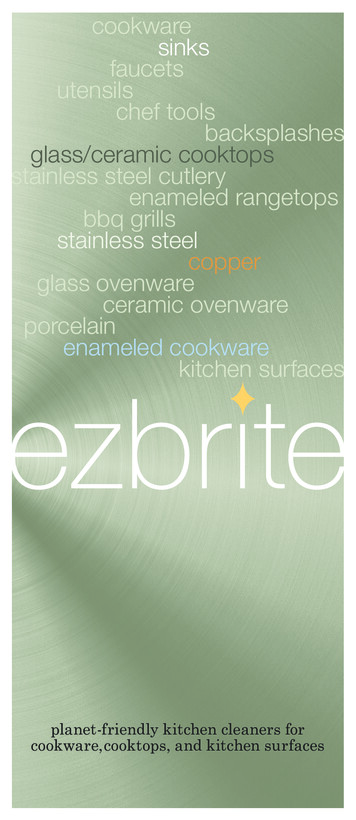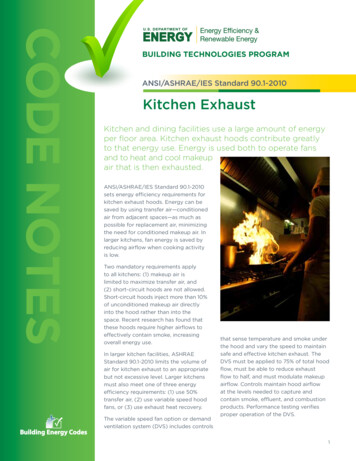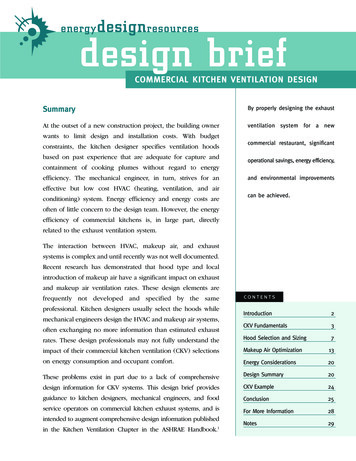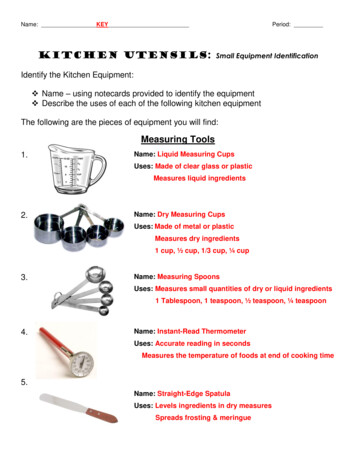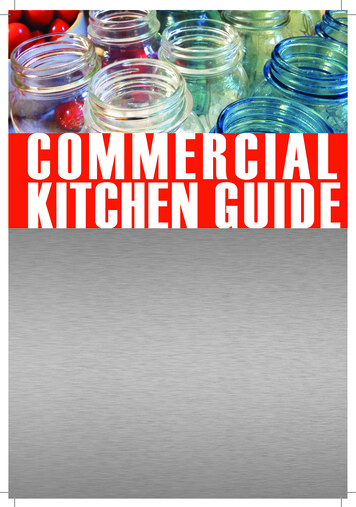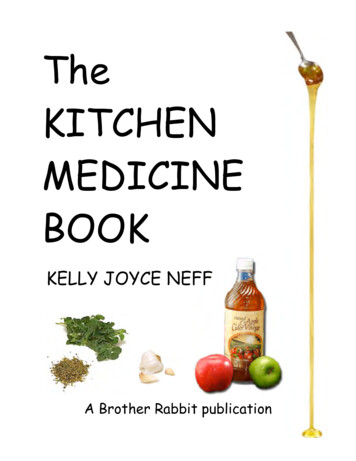
Transcription
TheKITCHENMEDICINEBOOKKELLY JOYCE NEFFA Brother Rabbit publication
To William Morrisand all my teachers, past and present2
INGREDIENTSINTRODUCTION.4One: RAW HONEY.6Two: APPLE CIDER VINEGAR.13Three: BICARBONATE OF SODA.20Four: SALT.23Five: WATER.36Six: CAYENNE.49Seven: GARLIC.53Eight: GINGER.64Nine: OREGANO.68Ten: TURMERIC.73Eleven: ROSEMARY.77Twelve: SAGE.84Thirteen: THYME.89Fourteen: PARSLEY.94Fifteen: BASIL.100Sixteen: RYE.104Seventeen: OATS.117Eighteen: HERB LORE.120Nineteen: HERBAL PREPARATIONS.143Twenty: OTHER REMEDIES, GREAT AND SMALL.151ABOUT THE AUTHOR.162BROTHER RABBIT.1653
INTRODUCTIONThe purpose of this book is twofold. The first is to impart a body of usefulknowledge of the medicinal and nutritional benefits of common kitchen items forthe maintenance and recovery of health in this day and age when we have movedfar away from such “common knowledge” in our fast paced and inorganic lifestyles.The urgency of recovery of such knowledge cannot be more acute, when healthinsurance costs are spiraling ever upwards, companies are restricting healthbenefits coverage to employees, and often people’s only recourse to health care isa very expensive trip to the hospital emergency room. While the informationcontained here is not intended as a substitute for proper medical attention, it may,I hope, be seen as an adjunct to it.Doctors have been touting “partnership with the patient” and “self-care” for yearsnow, as their own insurance costs and patient load restrict the amount of time andcare they can spent with and give to each patient. “Complimentary medicine” asherbal and other remedies are coming to be called, is the latest frontier in medicalscience. This book is not intended as a treatise on medical herbalism or nutrition,for that would require a volume many times larger than the scope of this littlebook can afford. Anyone interested in further study of herbal or nutritionaltherapies is invited to seek out any of the works listed here, or to make a study atthe local public library or on the internet (which itself has been a source of mostof the references herein). Do discuss what you find with your doctor ornaturopath; there’s much food for thought here, which can open up new areas ofinquiry between you and foster a relationship such as there used to be betweendoctor and patient.The second purpose of this book is to give the reader some idea of the vast storeof knowledge about these simple remedies which our human culture has accruedover the millennia, and thus in a small way to help preserve it. It is, then, as much a4
folklore study as a piece of self-help. The benefit of such folklore is that it putsus directly in touch with our human family through time – we remember that we arepart of the earth and of each other, that we are not in fact solitary units all aloneout there in the world, or the universe, but deeply connected, indeed inseparably,from each other. If the thought from a mind three millennia ago can touch us,move us, help us, how much more so the thoughts we project or receive fromothers near to us in space and time? We are all one together.May you be peace.Kelly Joyce NeffPacifica, CaliforniaAugust 20055
ONERAW HONEYRaw honey – which has not been pasteurized or filtered, and ideally taken directlyfrom the hive – is a treasure chest of nutritional value and medicinal remedies. Itcontains an abundance of vitamins and minerals, and is a natural and powerfulmedicine, both internally and externally.What can it do for us?The list of Honey’s beneficial functions is a long one. Honey increases calciumabsorption; can increase hemoglobin count and treat or prevent anemia caused bynutritional factors; can help arthritic joints, when combined with apple cidervinegar; fights colds and respiratory infections of all kinds; can help to boostgastrointestinal ulcer healing; works as a natural and gentle laxative; aidsconstipation, allergies and obesity; provides an array of vitamins and minerals; andsupplies instant energy without the insulin surge caused by white sugar. Many havefound raw honey helpful for its positive affects against allergies and hay fever,and one or two teaspoons last thing at night can help with insomnia. As anantiseptic, honey is also a drawing agent for poisons from bites or stings orinfected wounds, and has outperformed antibiotics in treatments for stomachulcerations, gangrene, surgical wound infections, surgical incisions, and theprotection of skin grafts, corneas, blood vessels, and bones during storage andshipment.“Raw honey is exceptionally effective internally against bacteria and parasites.Plus, raw honey contains natural antibiotics which help kill microbes directly. Rawhoney, when applied topically, speeds the healing of tissues damaged by infectionand/or trauma. It contains vitamins, minerals and enzymes, as well as sugars, all ofwhich aid in the healing of wounds.”6
So writes Dr. Cass Igram, D.O. in TheSurvivor's Nutritional Pharmacy. In afascinating modern development, scientists and doctors are beginning to rediscover the effectiveness of honey asa wound treatment. In recent years,honey has been used effectively inclinical settings for the treatment offist-sized ulcers extending to the bone,as well as for first, second, and thirddegree burns. Complete healing has been reported without the need for skin graftsand with no infection or muscle loss. It can be applied full strength to such conditions, covered with a sterile bandage, and changed daily. When the wounds areclean, honey acts as a healer. This also is the same procedure for infected wounds,ulcerations, and impetigo. Garlic honey can also be applied directly to infectedwounds which will help clean up the area of infection.Dr. Peter Molan, Professor of Biochemistry at Waikato University, New Zealand,has been at the forefront of honey research for twenty years. He heads theuniversity’s Honey Research Unit, which is internationally recognized for itsexpertise in the antimicrobial properties of honey. Clinical observations andexperimental studies have established that honey has effective antibacterial andanti-inflammatory properties. Astonishingly, it painlessly removes pus, scabs anddead tissue from wounds and stimulates new tissue growth. “Randomized trials haveshown that honey is more effective in controlling infection in burn wounds thansilver sulfadiazine, the antibacterial ointment most widely used on burns inhospitals”, explains Dr. Molan.Dr. Molan believes that if honey were used from the start in cases of septicemia,there would be far less tissue damage resulting. “The remarkable ability of honeyto reduce inflammation and mop up free radicals should halt the progress of theskin damage like it does in burns, as well as protecting from infection setting in”,says Dr. Molan. “At present, people are turning to honey when nothing else works.But there are very good grounds for using honey as a therapeutic agent of firstchoice.”7
Researchers believe that the therapeutic potential of honey is grosslyunderutilized. With increasing interest in the use of alternative therapies and asthe development of antibiotic-resistant bacteria spreads, honey may finally receiveits due recognition as a wound healer.Indeed, it works: raw honey makes a sterile, painlessand effective wound dressing. Apply it directly toopen cuts, abrasions and burns, and cover it with apiece of gauze. The results will occur quicker thanwith conventional alternatives, such as salves andcreams.Honey is exceptionally effective for respiratoryailments. One Bulgarian study of almost 18,000patients found that it improved chronic bronchitis,asthmatic bronchitis, chronic and allergic rhinitis, andsinusitis. It’s an effective treatment for colds, flu, respiratory infections, and agenerally depressed immune system. Whereas sugar shuts down the immunesystem, a good quality honey will stimulate it into action.Here are some more ways to utilize the healing power of honey:BURNS - Apply freely over burns. It cools, removes pain, and aids fast healingwithout scarring. Apart from being a salve and an antibiotic, bacteria simply cannotsurvive in honey.BED WETTING - A teaspoon of honey before bed aids water retention and calmsfears in children.INSOMNIA - A dessertspoon of honey in a mug of warm milk aids sleep and workswonders.HYPERACTIVITY - Replace all use of white sugar with honey. White sugar is highlystimulating with no food qualifies. Honey provides the energy without the “spike”!8
NASAL CONGESTION - Place a dessertspoon of honey in a basin of water andinhale fumes after covering your head with a towel over the basin. Very effective!FATIGUE - Dissolve a dessert spoon of honey in warm water or quarter honeybalance of water in a jug and keep in the fridge. Honey is primarily fructose andglucose, and so it’s quickly absorbed by the digestive system. Honey is a uniquenatural stabilizer: ancient Greek athletes took honey for stamina beforecompeting, and as a reviver after competition.FACIAL DEEP CLEANSER - Mix honey with an equal quantity of oatmeal, and applyas a face pack. Leave on for half an hour then wash it off. Great as a deep cleanserfor acne and other unwanted blemishes.POOR DIGESTION - Mix honey with an equal quantity of apple cider vinegar anddilute to taste with water. This is also wonderful for the joints – and promotesweight loss.HAIR CONDITIONER - Mix honey with an equal quantity of olive oil, cover headwith a warm tower for half an hour then shampoo off. Feeds hair and scalp. Yourhair will never look or feel better!SORE THROATS - Let a teaspoon of honey melt in the back of the mouth andtrickle down the throat. Eases inflamed raw tissues.FOR STRESS - Honey in water is a stabilizer, calming highs and raising lows. Useapprox. 25 percent honey to water.ANEMIA - Honey is the best blood enricher by raising corpuscle content. Thedarker the honey, the more minerals it contains.FOOD PRESERVATIVE – If you replace the sugar in cake and cookie recipes withhoney, they’ll stay fresher for longer due to honey’s natural antibacterial9
properties. Reduce liquids in the mixture by about one-fifth to allow for themoisture present in the in honey.BABY'S BOTTLE - Four teaspoons of honey to a baby's bottle of water is anexcellent pacifier and multivitamin additive. If the baby's motions are too liquid,then reduce the honey by half a teaspoon; if too solid increase by half a teaspoon.(Caution: Don’t give raw honey to babies under 1 year old; it’s just too rich.) Forteething, honey rubbed on a baby's gums is also a mild sedative and anesthetic.OSTEOPOROSIS – Research has shown that a teaspoon of honey per day aidscalcium utilization and prevents osteoporosis – probably not a bad idea for anyoneover 50.LONGEVITY - The most long-lived people in the world are all regular users ofhoney. An interesting fact, yet to be explained, is that beekeepers suffer lessfrom cancer and arthritis than any other occupational group worldwide.MIGRAINE - Use a dessert spoon of honey dissolved in half a glass of warm water.Sip at the start of a migraine attack, and, if necessary, repeat after a further 20minutes.CONJUNCTIVITIS - Dissolve honey in an equal quantity of warm water. Whencooled, apply as a lotion or eye bath.COUGH MIXTURE – Combine 6 oz. (170 g) liquid honey, 2 oz. (55 g) glycerin, andthe juice of two lemons. Mix well. Bottle and cork firmly, and use as required.Raw honey may become granulated, as some does after a week and another maybeonly after several years. If the granulations bother you, simply place the honeyinto a pan of hot water (not boiling) and let it stand until becoming liquid again.10
History and LoreHoney is collected and used worldwide and is one of the oldest and most revered offoods. The use of honey as medicine is mentioned in the most ancient writtenrecords.Sugar was unknown in the ancient world, and the Romans and Greeks had no wordfor it; honey was universally used as the sweetener of choice. Physicians in ancientRome used honey to help their patients fall asleep while Hippocrates, the famous5th Century B.C. Greek physician – hailed as the “Father of Medicine” – praisedhoney’s healing powers and formulated many honey-based cures for ailments suchas skin disorders, ulcers and sores; meanwhile, the ancient Egyptians used honey totreat cataracts, open wounds, cuts and burns.In World War I, German doctors used honey mixed with cod liver oil to surgicallydress soldiers’ wounds sustained in battle, and for years, singers have used honeyto boost their energy and soothe their throatsbefore performances.How does it work?Raw honey contains glucose and fructose, whichare easily assimilated monosaccharides (simplesugars), vitamins A, beta-carotene, all the Bcomplex vitamins, and vitamins C, D, E and K.There’s also an abundance of trace minerals:magnesium, sulfur, phosphorus, iron, calcium,chlorine, potassium, and iodine. Refined sugar,on the other hand, offers empty calories(disaccharides which have to be broken down inthe small intestine before entering the bloodstream) is man-made, and has nonutritional value, containing no vitamins, minerals or trace elements whatsoever.Which would you choose?11
Raw honey also contains a rich supply of live enzymes which are required for theproper functioning of all body systems. Like royal jelly, bee pollen and propolis,some active substances in honey have not yet been identified; hence they cannotbe chemically reproduced.A recent issue of Nursing Times reported on the significant case of a Britishteenager, the first instance in which honey was used on multiple meningococcal skinlesions. The antibacterial action was evident, as the mixed infection ofPseudomonas and Enterococcus cleared from the lesions in a few weeks and thenumber of colonizing staphylococci diminished to a harmless level. Meanwhile, Dr.Peter Molan’s important research in New Zealand has been described above.Raw honey is a tonic (a beneficial, supportive stimulant) to all systems. It’santibiotic, antiviral, and has been scientifically proven to be hygroscopic (i.e. itabsorbs water). It also contains the enzyme glucose oxidase, which converts tohydrogen peroxide when exposed to water. Add this to the fact that no bacteriacan live in raw honey, and it becomes a clear and natural choice for healthconscious individuals, whether it’s in your cookies or in your first-aid kit.12
TWOAPPLE CIDER VINEGARThe well-known saying “An apple a day keeps thedoctor away” is actually derived from the old Englishsaying:“To eat an apple before going to bedwill make the doctor beg for his bread.”The undisputed benefits of eating apples, however, canbe further multiplied many fold by the consumption ofApple Cider Vinegar (ACV). A veritable host ofvitamins, minerals and other nutrients and substancesis available in ACV to improve and reinforce health.What can it do for us?The Bragg family, who make the famous Bragg’s Apple Cider Vinegar, like to tell thefollowing story. Farmer Bragg had an old hen prepared for dinner. The old hen'smeat was tough and didn't taste good (this being what happens to poultry and beefwhen it’s deficient in potassium; human flesh suffers the same problems). To proveto the children that ACV and raw honey needed to be an important part of theirdaily nutrition, he would then select another old hen for the dinner table. But thistime he fed that old hen ACV twice a day. For a week to ten days he gave the henthe ACV mixture. When the hen was prepared for the dinner table, the childrensaw the difference in the old hen's meat. They tasted how tender it was. It wasjust like eating a young hen.When acid crystals harden in the joints and tissues of any animal, the jointsbecome stiff and the tissues become hardened. The meat becomes tough andtasteless. But, when the animals are given ACV regularly, the precipitated acid13
crystals enter into a solution and pass out of the body, thus making the bodytissues healthier and tender. This applies to human flesh also.Now, when body tissues hold all the precipitated acid crystals they can, thecrystals next appear in the bursae and the joints of the body, resulting in arthritisand bursitis. 1 to 2 teaspoons of ACV with 1 to 2 teaspoons of raw honey in a glassof water daily will help relieve the stiff aching and prematurely old joints. You bethe judge. See how elastic and well oiled your joints will become!Even the very healthiest people must continually fight the build-up of acid crystalsin the body. The strongest solvent of acid crystals is a simple drink made up ofACV, raw honey and water. This powerful daily mixture puts the acid crystals insolution so they can be flushed out of the body by the kidneys and other organs ofelimination. The malic acid content of the ACV dissolves calcium deposits in joints,while ACV acts to balance the acid-alkaline pH levels in the body and helps tooxygenate the blood.Animal proteins and fats have a tendency to thicken the blood. Blood has tocirculate all over the body through the arteries, blood vessels and tiny capillaries,and it’s impossible for blood to circulate freely through these incredibly thin pipeswhen it’s thickened with too much protein. However, the natural acids in ACV helpkeep the blood healthier and thinner. It’s been reported that soaring bloodpressure can be dramatically reduced by a 48 hour fasting program with only ACV,raw honey and water (five glasses a day plus additional water) being taken; a longerprogram, without the fasting, is said to work just as well.ACValsopreventsthegrowthofbacteria and mold. The acid content ofACV helps reduce the chance of bacterialor fungal growth on fresh foods. If youuse conventionally grown produce, you canremove pesticide residues by sprayingfruit and vegetables with ACV, then waitfive minutes and rinse. Similarly, toeliminate bacteria (from either organic14
or conventional produce), spray with ACV, wait five minutes and rinse. ACV can alsobe sprayed on seeds during the sprouting period to prevent the growth of bacteriaor fungi: simply place ACV in a mister bottle and spray your seeds thoroughly withACV after each rinse with fresh water until the seeds are sprouted. You can rinsethe ACV from the sprouts before serving if you dislike the taste!ACV has been helpful as an aid for digestion, helping to break down minerals,protein and fats. It also inhibits the growth of unfriendly bacteria in the digestivetract. ACV has detoxifying properties, strengthens the immune system and mayameliorate viral, bacterial and fungal infections. It’s used as an antibacterial andanti-inflammatory medicine and has a natural antibiotic effect.Its benefits also include alleviating respiratory infections and may reducesymptoms such as watery eyes and nasal discharge with complete relief of pollen,food and pet allergies. If you live in a highly polluted area where allergies and sinusinfections are rampant, your system maybetter balance itself with a small dose of ACVeach day. ACV has also been reported to curesinusinfections,acne,highcholesterol,chronic fatigue, Candida, acid reflux, sorethroats, contact dermatitis, arthritis, andgout; many find it to be a general energytonic. It can be used to sooth sunburns andinsect bites, to make your hair shine, and totreat dandruff. A wonderful side effect of drinking ACV every day is that it bringsa healthy, rosy glow to one’s complexion. This is great news if you suffer from apale countenance! And, what’s more – although no-one is quite sure how – ACV alsoseems to break down fat and is widely reported to be a gradual, yet permanent andeffective aid to losing weight.Many commercial ACVs have been pasteurized, filtered, refined or distilled inorder to make the product look good, and thereby more appealing to the generalpublic. Unfortunately this extra processing destroys much of the healthy goodnessof the product. The best type of ACV to use is one made from cold pressed,organically grown whole apples, to which no chemicals or preservatives have been15
added, which contains the “mother of vinegar”, and is not pasteurized. This“mother”, as it’s affectionately known, is a natural gelatinous substance formedduring the final fermentation step. This type of especially wholesome ACV can befound readily in most health food stores and even in some general grocery stores.History and LoreThe benefits of ACV have been recognized for a long time; for over 10,000 yearspeople have used vinegar in one form or another as both a food and a medicine forthemselves and their animals. It’s intriguing to think that in today’s computerized,sophisticated world, we’re still using one product which was discovered – quite bychance – so many millennia ago, when it was discovered that a cask of wine gonepast its time had turned into a wonderful new product.The ancients were quick to explore the remarkable versatility of vinegar. In 5,000B.C. the Babylonians were fermenting – in commercial production – the fruit of datepalms to make date vinegar, and besides consuming it also used it as a preservative.The Ancient Egyptians sang the praises of vinegar as far back as 3,000 B.C.; oneEgyptian jar dating back to 8,000 B.C. was used to contain vinegar. Records showthat the Egyptians were using ACV in particular not just as an antiseptic, but as aweight loss agent as well. And in later times, Cleopatra demonstrated vinegar’s solvent property by dissolving precious pearls in it to win a wager that she could consume a fortune in a single meal.In ancient Greece, Hippocrates strongly advocated drinking vinegar for his patients as an energizing tonic and a healing elixir. Oxymel, a medicine he often prescribed, was a combination of honey and vinegar; he instructed his students thatthey would find the drink very useful for expelling phlegm and promoting freedomof breathing. Hippocrates also used vinegar externally, for cleaning ulcerations andto treat swellings, inflammations and burns. Meanwhile, the Romans made vinegarfrom grapes, dates, figs and rye. (The word vinegar comes from the French vin ai-gre; it was actually called aceto, meaning “acid”, by the Romans.) Caesar’s armiesused sweetened diluted vinegar called posca (poor man’s wine) as a preventativemedicine much as we take vitamins today, to cook with, for its antiseptic propertiesagainst insect and snake bites, and to clean their wounds after battle (a life-saving16
practice emulated as recently as in World War I). In the 2nd Century A.D., thegreat physician Galen prescribed the combination of honey and vinegar for coughs.It’s also recorded that Hannibal used vinegar to remove boulders in his path acrossthe Alps by heating the boulders, and then dousing them with cold vinegar whichcracked into smaller moveable stones; and when faced with slippery snow, he usedvinegar to dissolve it.During the Sung dynasty in ancient China, vinegar was listed by Tzu-Mu as one ofthe seven necessities that even the poorest people couldn’t do without. AncientJapanese documentation has vinegar reaching an art form in the Heian Period withthe addition of vinegar from fruits and flowers. In the 17th Century, Europeansdiscovered the medicinal value of vinegar and prepared antiseptic vinegar, vinegarsyrups and a variety of medical types of vinegar. In 1703, B. Boyles, a fellow of theRoyal Society of London, recommended vinegar as a gargle.Vinegar was a common food preservation method – for vegetables as well as forfruits and meats – since ancient times. Salting, pickling and dehydrating were theonly ways to preserve food for thousands of years and a number of such recipeswere developed by trial and error.How does it work?It’s suggested that ACV has such curative abilities because it causes the pH(acidity) levels to become more alkaline or, in the case of too much alkalinity, moreacidic. Urinalysis studies done in the 1950s by D. C. Jarvis (author of FolkMedicine) showed that pH levels in the body become highly alkaline before andduring an allergy attack (contrary to what you would normally read on the subject).If you’re going to try ACV for allergies, or even to prevent sickness, we suggestyou do some investigation of your own by buying a pH test kit at a local pharmacy,garden nursery, or even pool supply store. You can use these kits or pH strips totest your urine to see if you are more alkaline or acid during an allergy attack, virusor bacterial infection. Once you ascertain your pH levels, you can adjust yourdosage of ACV accordingly. Experiment to find the pH balance at which your bodyfunctions optimally.17
ACV in itself is alkaline because of its ashcontent; this means if the ACV is burned, what’sleft over becomes ash. When you check for thepH of that ash and dissolve it with water, thecontent is alkaline. Whenever our body digestsanything it undergoes oxidation, which is similarto burning. The end result is that you candetermine whether the end product is alkaline oracid.ACV has anti-fungal, anti-bacterial, and antiviral properties, primarily coming from the malicacid and acetic acid portion of the vinegar. ACVacts as a buffer in the body because the aceticacid reacts with base or acid compounds to forman acetate, therefore rendering them chemically bioavailable for the body’sutilization. Additionally, ACV can reduce the toxicity of certain compounds byconverting the toxin into an acetate compound which is less toxic. This is why ACVworks so well for insect bites and certain skin allergies.Scientists have measured ninety different bioactive substances in ACV, such asthirteen types of carbolic acids, four aldehydes, twenty ketones, eighteen types ofalcohols, and eight ethyl acetates. ACV provides enzymes and important mineralsand trace elements such as potassium, calcium, magnesium, phosphorous, chlorine,sodium, sulfur, copper, iron, silicon, fluorine and other trace minerals. ACV’s vitamincontent includes Vitamin C, Vitamin E, Vitamin A, Vitamin B1, Vitamin B2, VitaminB6, beta-carotene, and Vitamin P (bioflavonoids). ACV also contains malic acid,acetic acid, tartaric acid, propionic acid, lactic acid, numerous enzymes, and aminoacids, as well as roughage in the form of potash and apple pectin.The secret of ACV’s amazing nutritional value goes beyond the nutritious appleswhich form its basis, and comes from the fermentation of apple juice to hard applecider, followed by a second fermentation to ACV itself. This natural productretains all the nutritional goodness of the apples from which it was made, and it’salso fortified with the extra acids and enzymes produced during the two18
fermentation steps. It's the sum of all these ingredients that give ACV its amazinghealth benefits. Be aware that if you choose to buy white distilled vinegar, it hasnone of these beneficial constituents!19
THREEBICARBONATE OF SODA (BAKING SODA)Many components of the modern western diet –meats, fish, dairy products, most grains, sugars,alcohol and caffeinated drinks (in fact, almosteverything except vegetables, millet, most fruitsand, as we have just seen, Apple Cider Vinegar) –contribute to one’s body becoming too acidic. This inturn can open the door to a variety of problems,some of them (including arthritic complaints)potentially serious if this acidic condition persistsfor many years.This is because your body will attempt to compensate by retaining alkaline salts inthe bloodstream to offset the increase of tissue acidity. Since your body can onlytolerate a small imbalance in blood pH (the acid-alkali balance), it will rob alkalinecomponents from other places – including your body’s precious alkaline reserves – inan effort to restore a proper pH equilibrium. This can result in heartburn,digestive distress, stomach upset, fatigue, and a multitude of other symptoms.Simple, inexpensive kitchen baking soda can fix this.What can it do for us?Very useful in keeping the body healthily alkalized is half to one teaspoon a day ofbaking soda in water. Don’t take it with or within an hour of meals, though, as thestomach needs to retain its acidity in order to perform its digestive functionseffectively. A great deal of tap water (or even store-bought spring water) issurprisingly acidic; filtration will remove toxins but will not affect the pH balanceof the water. (Baking soda can be used to reduce the corrosion of acidic drinkingwater in municipal water supplies, therefore reducing the toxicity of the lead andcopper which are dissolved from the pipes.) You can purchase a pH testing kit for20
home use very cheaply, and if the water you usually drink is acidic (i.e. with a pH ofless than 7.0), you could remedy this cheaply and easily by adding a pinch of bakingsoda to all the water you consume.Baking soda is also effective for polishing teeth (without scratching the toothsurface) and fighting bad breath (sprinkle a little on the toothbrush bristles). Itcan even be tried for exfoliating skin when acne is a problem (add a little to afacial cleanser in place of using a commercial facial scrub).When baking soda is added to bath water, sunburn sufferers often experience anotable reduction in pain. Place a cup (8 ounces) of baking soda under the runningbath tap so it dissolves completely, and soak in a lukewarm tub for about half anhour. Such a bath will soothe the pain – and you won’t have to endure the stingingsensation of a shower. Adding baking soda to a hot bath at any time also helps washacid wastes out of the body.In addition, baking soda can be used in cool (but not cold) bath water to sootheother skin irritations and alleviate itching from prickly heat, bee stings, insectbites, and other minor skin ailments. A paste (made with just enough water to getthe desired sticky consistency) placed on an insect bite or sting and allowed to dryis a time-tested approach f
BED WETTING - A teaspoon of honey before bed aids water retention and calms fears in children. INSOMNIA - A dessertspoon of honey in a mug of warm milk aids sleep and works wonders. HYPERACTIVITY - Replace all use of white sugar with honey. White sugar is highly stimulating with no food qualifies. Honey provides the energy without the "spike"!

